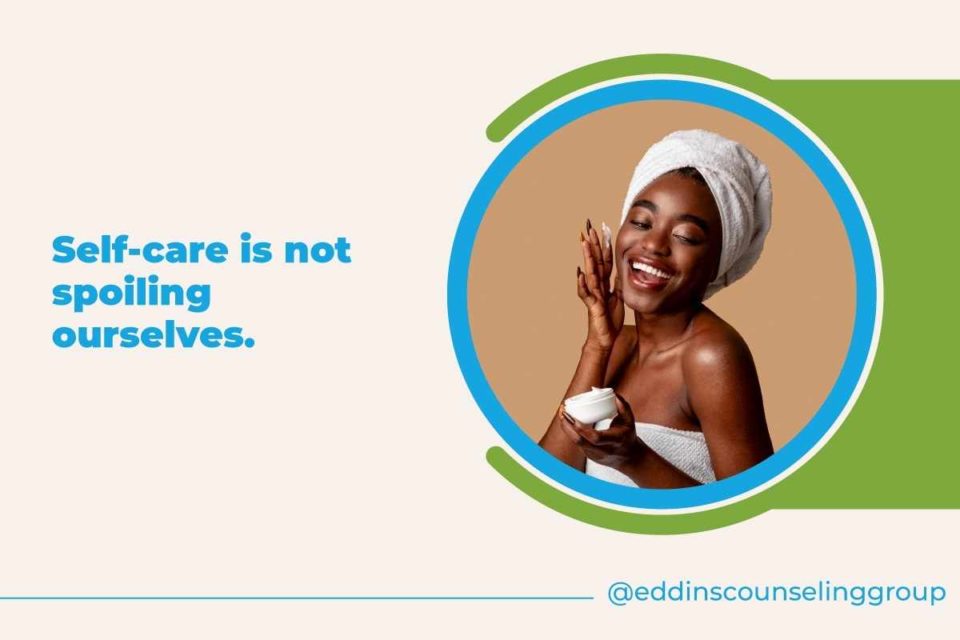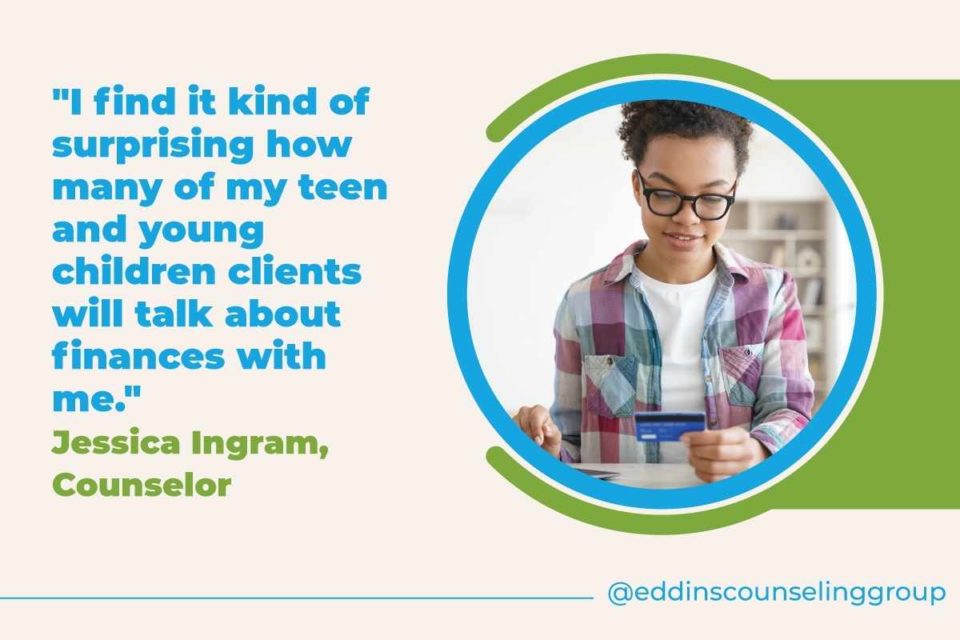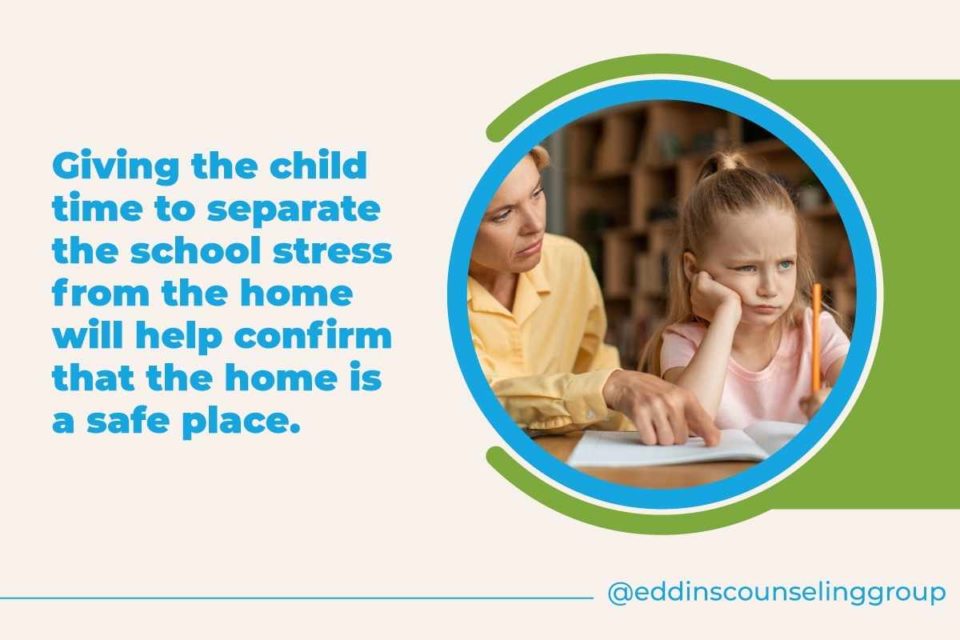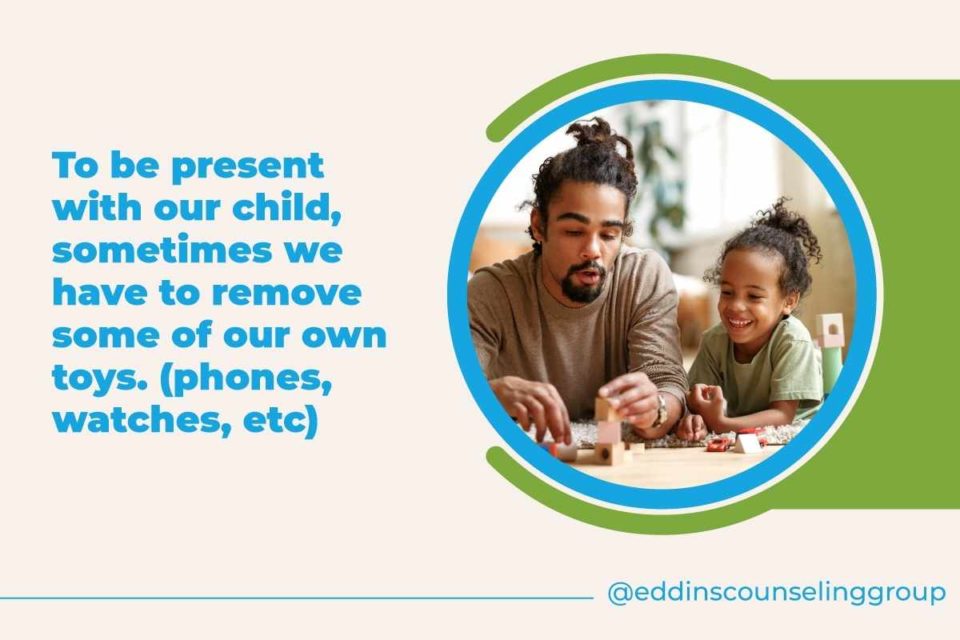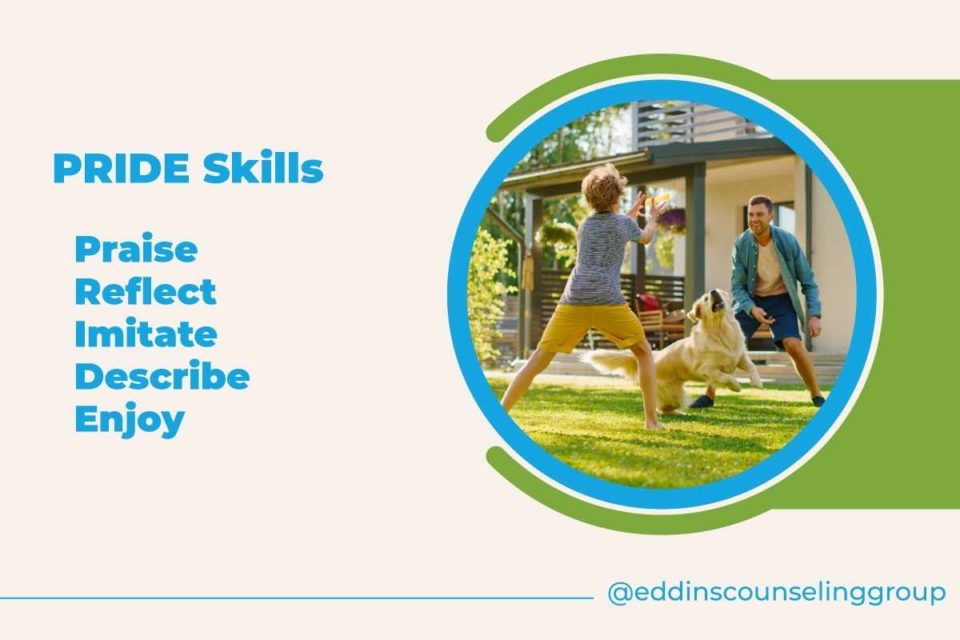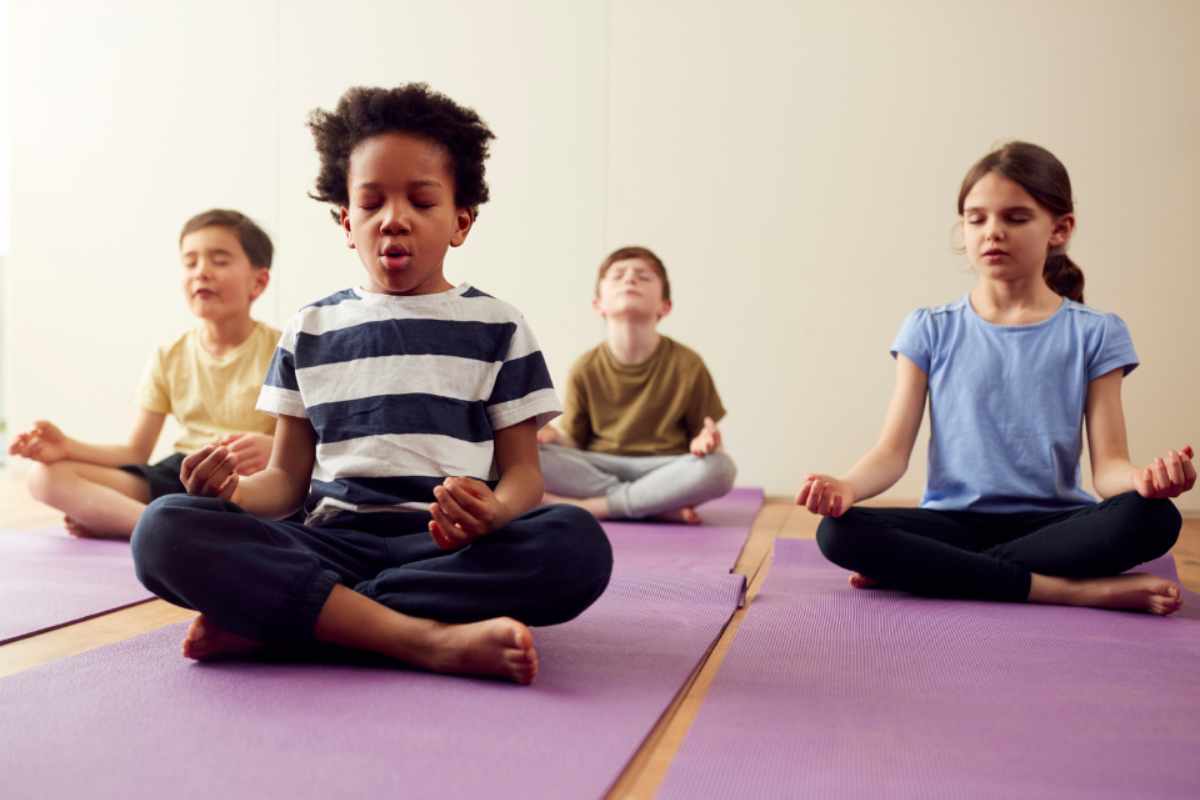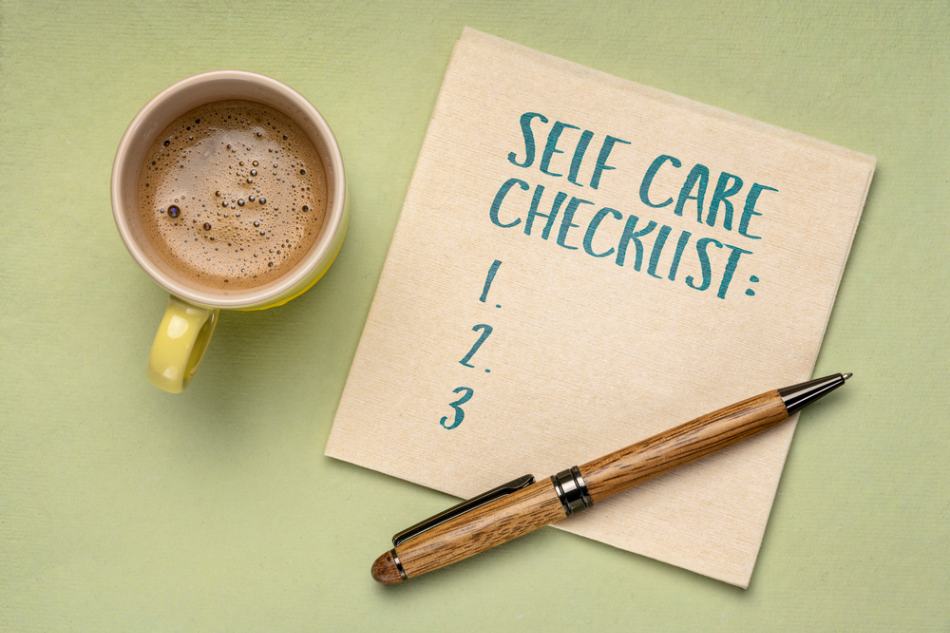July 23, 2022
Webinar: On Being a Parent
Written by Rachel Eddins
Posted in Parenting & Family, Webinars and with tags: Communication, children, parenting

This webinar will give parents activities and skills you can use to increase communication with children and ways to deal with the stress of being a parent.
This webinar is facilitated by Jessica Ingram, LPC.
Watch a replay of the presentation here.
Learn more about our Parenting & Family counseling services.
Here is a transcript of the webinar:
My name is Jessica Ingram and I am an LPC at Eddins Counseling Group. I’m a licensed professional counselor and I am also EMDR trained I do a lot of work with moms, kids, and teens and a lot of parent training. I’m here today to share our webinar on “being a parent”.
So most importantly, I want to say thank you for taking your time out of your day to spend an hour with me and the other parents, talking about what it is to be a parent, to talk about some of the highs as well as the lows of this wonderful and unique experience. Being here does show that you care.
I feel like a lot of parents stress about what they’re putting in, if they’re a good parent, and if they’ve done this situation well, but reaching out to find resources on being a good parent, on taking care of your child, learning new skills is amazing. That shows that you are thinking about your child, you’re thinking about the interactions you’re having with your child, and that you are a good parent.
Who wants to know all the answers about parenthood?
We don’t have them! Every parent is going to be different. Every child is going to be different.
There are certain things that we can teach about parenting that help encourage:
- positive experiences,
- good developmental skills from the child, and
- attachment between the child and the parent.
But, not everything is going to be cookie-cutter. I think we all know this, but it can be stressful, not feeling like we can have all the answers at our fingertips.
I hope you can leave having a little bit more knowledge as well as knowing that other parents are struggling with these things as well.
First, today’s focus is to do a grounding exercise. I know it’s been a long day, and we’re probably all tired, so I want to take a moment to focus on us. And then I want to talk about parenting stressors. What do you find?
You struggle with things that happen pretty regularly as well as things that come out of the blue that we just don’t feel like we handle. I think that would be great to talk about.
The main focus that I want to talk about today is parent-child interaction therapy, PCIT, and specifically PRIDE skills.
Later, I want to work on or talk about where you relate to these skills, if this is something that you feel like you do well in, or areas that you feel like you would struggle in, incorporating these with your child.
Grounding Exercise
We have to know how to take care of ourselves before taking care of others.
First, as a parent, we focus so much on that child, our whole world shifts. But we have to know who to take care of, and how to take care of ourselves before taking care of others.
Thinking about being in the airplane. They say you have to put your own air mask on before helping anybody else. When we aren’t taking care of ourselves as a parent, as a person, and as our own human, we don’t have the same capacity to give as we would if we were fulfilling ourselves.
With the parents that I talk with and the clients, I feel a lot of guilt from parents when they do want to go take time for themselves or they want to spend money on themselves and not necessarily on the child. Even on certain things that are good. You are your own human as well.
We have to make sure that we’re taking care of ourselves. So as long as our child’s needs are being met, it is okay to spoil yourself here and there, too.
Doing grounding exercises and self-care is not spoiling ourselves. That is something that needs to be just embedded in us.
Teaching ourselves how to have that self-care and that boundary will also teach our children to have that through the stages of their lives. Let’s take a moment and focus on taking a little body scan from the top of your head all the way down, closing your eyes if you feel comfortable:
- Take those deep breaths in through your nose, out through your mouth, noticing any tension you feel in your body. I immediately dropped my own shoulders.
- Notice your jaw, notice how your neck feels, how your shoulders feel.
- Take a moment, notice how your chest feels. If it’s tight with each breath, try to push through that tightness or the uncomfortableness we feel in our bodies.
- Notice our stomachs, whether we’re hungry, waiting on dinner, or if we’re stuffed from dinner, just paying attention to how our body feels right now.
- Focus on our legs and knees, focus on our shins, our calves and our ankles. We need to flex them and twist them.
Now take a moment to acknowledge why you are here today. Acknowledge that you are a good parent.
What Stresses You Out?
Some days it feels like everything makes us feel stressed. And there are other days where, at the end of the day, it explodes and everything lands on us. Take a moment, notice what stresses you out. All the little tiny, small things that annoy you, the petty things that annoy you, as well as the big things that stress you out, and those family stressors where we’re really trying to solve a problem.
Common Stressors for Children and Parents:
- Change in routine
- Change in the family dynamic
- Change in finances
- New experiences where we feel ill-equipped
- Holidays with extended family
- School/work stressors that affect how we interact with loved ones
- When our children start to assert independence
Change in Routine
Common stressors for the child and parents that I really thought were kind of across the board that people have experienced a change in routine. Children thrive off of routine. And when there’s a change in it, it gives us a hiccup.
A lot of the time when I talk to parents, I find that sometimes we forget that children are humans, right? They’re not just these little kids that are screaming and having tantrums and are loud, but they have all of the emotion capacities that we have.
Children have a lot of the same triggers that we have, the same stressors that we have, and they have less control over their experience.
One, either they don’t have the emotional capacity or the knowledge to understand everything. And two, as a child, you’re not scheduling school or play dates or you don’t have bills. You don’t have all these other things that you’re having to incorporate, but life is happening to them, right?
As an adult, like myself, if my routine gets out of whack and I’m not aware of why or how or I had no time to prepare, of course I’m going to be affected. I’m probably going to have my own little tantrum.
And then there are routines that we do know are going to change, right? So when the routines that we know are going to change, I find it helpful to express that to our children, to have that talk the night before:
“Hey, this isn’t going to happen tomorrow, or I know we haven’t gone here before, but we’re going to go to this new store, we’re going to go see Grandma and Grandpa.”
Whatever it is that’s new out of the routine.
It’s really helpful to start communicating that to the child a day before, two days before, three, whatever feels comfortable so that they feel like they have some control in that routine.
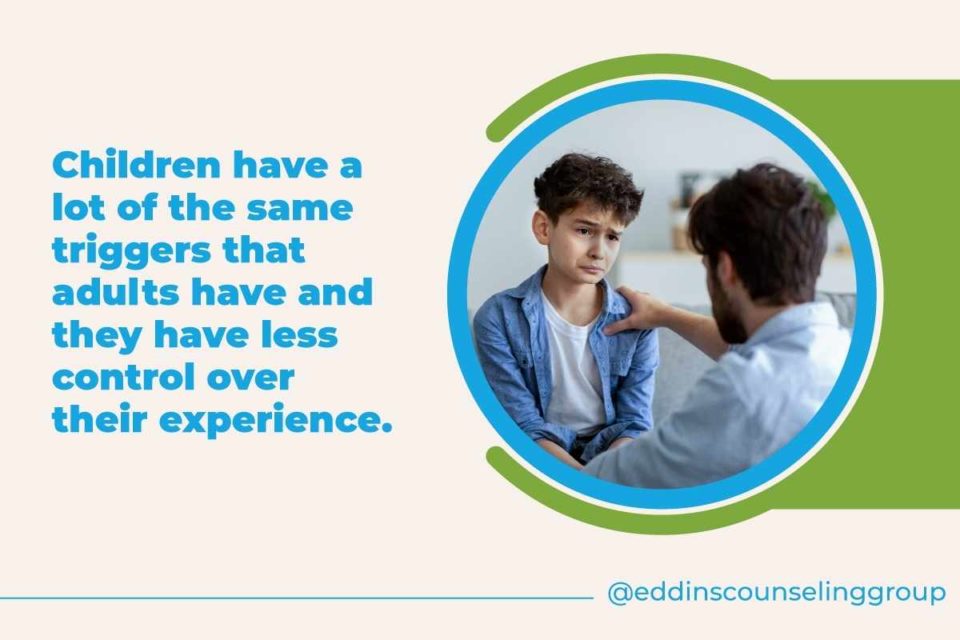
Change in the Family Dynamic
Another big stressor is when there’s a change in the family dynamic, right? We have family members move in with us, we have family members move out, we have divorce, separation, we have new partners, new girlfriends, new boyfriends, etc.
In some families, we have siblings that are going off to college and siblings that are still very young. Changes in that dynamic and the people in that core house, that’s going to make a big disruption.
We’re stressed and we’re moving through it, but we have to slow things down and notice that there is now a change and acknowledge it’s going to take a second for us to get used to this new system.
Change in Finances
This is the same with changes in finances. That can be very stressful for parents and we’re in a state of unknown. Right now, things are getting really tight with money and it can be hard to look at all the positive things and to go and do all the fun summer activities when we are worried about money.
It’s really important to find those free activities and those low-cost activities. But that can cause stress, which obviously can cause stress for adults. And when our adults are stressed, our kids can become stressed and it just trickles.
I find it kind of surprising how many of my teen and young children clients will talk about finances with me. They’ll acknowledge that counseling is expensive or they’ll acknowledge that “We’re not going on vacation this summer because of X, Y and Z”.
So it is kind of surprising how much they are paying attention to even those types of things.
New Experiences Where We Feel Ill-Equipped
Other common stressors are new experiences where we feel ill-equipped. As adults, we don’t like that feeling. We get anxious, we get overwhelmed. Children feel that same way, they’re just not able to express that the same.
Holidays with Extended Family
Holidays with extended family can also be stressful.
School/Work Stressors That Affect How We Interact with Loved Ones
School/work stressors, which affect how we interact with loved ones are really big and there are two parts. So the first part is being an adult and being a parent.
If we’re out of the home working and we’ve had a horrible day and this boss said something or this meeting went bad, when we come home, we want to really pay attention and focus on not projecting that day on our household and on our child.
That’s really hard to do, especially nowadays where we’re halfway online all the time or we’re working from home and that home life to work life doesn’t have that big separation anymore. It can be hard not to carry on those stressors onto your child.
We don’t want to be still upset and worried about that and angry when we’re feeding our kids and being mad at them because now they’re not eating all of the food and they’ve had a tantrum now. And now both our nervous systems are out of whack.
So, acknowledging that and noticing that in our bodies is really important. And that goes back to that self-care and that grounding exercise that I talked about in the beginning.
We have to be able to take care of ourselves as parents and as adults before we take care of our children.
So when we notice that “I’m not where I should be right now, my circuit is going to be this short. What can I do?”
“Can I do a grounding exercise before I leave my office? Do I need to drive around the block another round? Do I need to go for a walk?”
Depending on the age of the children, and if you have a partner… talking to your partner and say, “I need five to ten minutes to decompress before I come inside and get all the children’s hands on me”.
Talking to your partner about that can be very helpful so that you can decompress beforehand.
But on the other side, with children and with going to school, they don’t necessarily have that partner to lean on and they don’t necessarily have all of the knowledge of our bodies and how we’re out of whack and how we’re stressed and how we’re overwhelmed. They just kind of feel angry and mad and they don’t know anything more than that.
A lot of the times the child comes home and the parents go: “Homework, chores, go outside, you have to do this and this, why haven’t you done this?”And there’s no time to decompress.
I know that can be hard when we have athletes or it’s a busy schedule and we got to get that homework done or the child takes a long time to get their homework done.
But giving the child time to separate the school stress from the home will help confirm that a home is a safe place for them so that they can release that and they can set those boundaries with themselves, their parents, and the school.
When we have a bad day and we’re upset, we call our friend or our spouse. We just want to complain. We just want to feel validated. And we want to hear “Yeah, that sucks. Yeah, that wasn’t right” and affirmed why we are feeling those emotions and that it’s valid. And children need that as well.
When older children complain about school, take a moment to reflect, to just affirm and validate their experience. This can be so empowering for them because they’re sharing this information that they might not be sharing with friends or if they’re young, they’re just talking about nap time was hard.
“Yeah, we talk about nap time, that can be hard. How can we make that easier for you?” And we’re talking about it affirming way and not immediately going into that fix or immediately going into dismissal.

When Our Children Start to Assert Independence
The last comment stressor is when our children start to assert independence. This can look different depending on the age of the children.
So when toddlers and young children are trying to assert dominance or assert independence, that can be very frustrating for the parent because they don’t have the skills to do it right. So they want to pour their own milk, but it spills every time. They want to brush their teeth, but they’re not doing it well. They want to get dressed, but it’s a mess. But that’s how they’re showing their independence. Or even if they say: “I want to draw this, I want to do this myself”.
Things don’t necessarily run as smoothly. So a lot of the times parents get frazzled, they get upset, they get heated, we’re in fixer mode, and it’s like “let me just do it because I can do it right”. And we kind of get elevated like that.
That’s so normal and that’s okay, but we need to acknowledge that and say: “Okay, you’re really trying to do this on your own. Maybe I need to give both of us five more minutes for this activity or two more minutes for this activity so that there is that availability for that”, or “Okay, I need to do this one or two more times and we’re not in that time frame”.
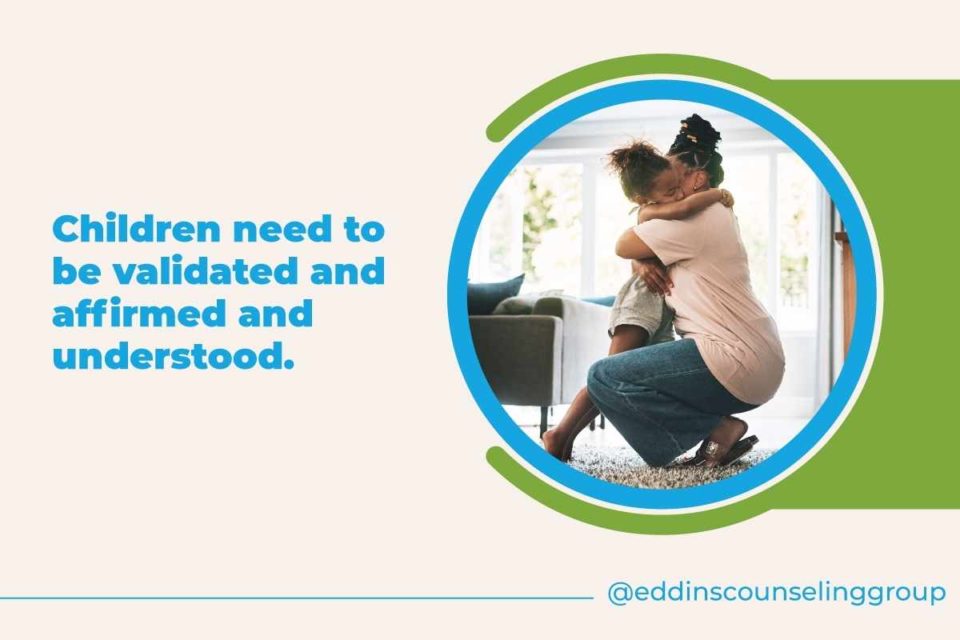
Parent Child Interaction Therapy (PCIT)
- PCIT is an evidence-based treatment developed by Sheila Eyberg and she focused on children ages 2-7 with behavioral and emotional issues/disorders.
- Usually, this is an in person training through multiple sessions and phases where the counselor actually uses a bug in your ear to help coach through interactions with your child.
- Learning about these skills can be really utilized for children of all ages.
The main thing that I wanted to talk about today is Parent Child Interaction Therapy or PCIT.
PCIT is an evidence-based treatment developed by Sheila Eyberg, and she focused on children ages two to seven with behavioral and emotional issues and disorders. And with PCIT, it’s usually in-person therapy with multiple sessions in different phases of the sessions where the counselor actually uses a bug in your ear to help coach through the interactions with the child.
So the parent and child play and the counselor/therapist is in the ear, kind of directing the parents on how to respond, how to interact, how to sit, all those types of things. I’m just trying to give you some skills, some things to put your hands on, to implement and practice at home and start seeing some changes in the home.
And if you want to learn more about it, please feel free to reach out. There are a lot of really good benefits from this as well as doing my own research on this I really was reading it and thinking this could be utilized across the board.
Yes, we’re talking about playing on the floor with children, but adults need this information, too. Teenagers need to feel this way.
It can really be used throughout all ages. I would also be curious to hear how you could implement it with your older child or somebody that you know that is older.
PCIT: When and Why?
The PCIT is during play, during interactions with your child when we’re on the floor or outside and we’re just having fun.
PCIT has two forms:
- CDI – Child Directed Interaction
- PDI – Parent Directed Interaction
There are two forms of PCIT, one is child directed interaction, and the other is parent directed interaction.
We’re going to focus on Child Directed Interaction. Doing this will decrease tantrums and outbursts, negative attention seeking, as well as parent frustration, which I know is very important.
This increases security in the child, self-esteem as well as social skills because we’re communicating with them or interacting with them, and they’re going to see that. And they’re going to see that and start imitating that back to us.

What is Play?
Ask yourself your own relationship with play and the internal self-talk you have when you play for yourself and when you play for/with your children
First, I want you to take a moment and ask yourself about your own relationship with play.
- Do you remember playing as a child?
- Do you remember playing as a teenager, or as a young adult?
- How do you play now as an adult? And what is that internal self-talk?
- When you experience this when you do it for yourself, are you making fun of yourself?
- Are we talking poorly? Do we think it’s stupid?
- As well as what is that self-talk when we play for and with our children, are we knowing that it’s just something I have to do?
Are we hoping, “Okay, I have a 30 minutes time slot, I’m just going to do this, and hopefully she’ll go to sleep afterward”? Or are we sitting there excited to engage with our child and spend time with them and see them laugh, crawl, play, explore and build? What is that for you?
Play is Different than Teaching
What does playtime look like?
- Is the TV on, do you have your phone on?
- Where is your mind?
I want to acknowledge there’s a huge difference between play and teaching.
So when we’re teaching, there are times where we give commands, where we do corrections, where we ask a lot of questions and we say: “Okay, what is this? How does this make a sound? How do we build this?”
We’re engaging, but it’s a lot of questions and learning. This is especially for young children and learning what’s a cow, what’s a pig, what’s a number, and what is this shape? That isn’t necessarily play.
What does your playtime look like? Are we inside? Are we outside? Do we have the TV on? Do we have our phone or watch on? And where is your mind?
I know a lot of people now really try to focus on not putting the TV on as much. But we’re all attached to our phones, almost all of us have Apple watches or some type of smartwatch. It’s important to not be on these devices when we’re playing with our child, to not just be sitting down.
We can get stuck doing that and we can get distracted and do that. And time passes and we really want to be present and be focused on that child. Now with our watches, I really try to suggest for my parents to take their watches off when they play because it is so easy to just check real quick.
But if I’m doing this, my arm is across from me, you can’t see me, I’m obviously paying attention to something else, right? It’s the same as being on the phone or it’s the same as watching the TV and not paying attention.
It can be very easy to get distracted, so I like to just put them somewhere else. This is not our fault, it is just part of the culture now. But we have to be aware of that.
To be present with our child, sometimes we have to remove some of our own toys.
PRIDE Skills
Praise – You’re teaching your child what behaviors you like
Reflect – Repeat and build upon what the child says to show that the parent is listening and to encourage improved communication
Imitate – Shows your child you see them and approve of what they are doing
Describe – Shows your child you see them and understand them and understand what they are doing
Enjoy – Promotes healthy attachment, makes it more fun for both parent and the child
With PCIT, the main thing I want to focus with our pride skills.
PRIDE stands for praise, reflect, imitate, describe, and enjoy.
With Praise, you’re teaching your child behaviors that you like. You’re acknowledging things that they’re doing well. We’re also ignoring the inappropriate behaviors unless there are safety concerns, but we’re just avoiding, we’re not looking, we’re not giving enough attention to the negative ones and we’re only focusing on those positive praiseworthy behaviors.
With Reflect, we’re repeating and sometimes building upon what that child says. This shows that the parent is listening to and encouraging improved communication. When you continue to reflect on what your child is saying, it’s kind of making that conversation role, and that communication skills can be built.
The next is Imitate. So show your child you see them and approve of what they are doing.
Describe, show your child you see them, and understand what you’re doing. Narrating what is going on. That is one of the biggest things that I talk about with parents, is just narrating what you see.
The last is to Enjoy it. This promotes a healthy attachment. It makes it more fun for both you and the child. We want to be able to have fun, we want to be able to relax and be silly.
And sometimes we have to allow ourselves to do that. And it takes a moment, but we want you to enjoy your time with your child.
What Does Praise Look Like?

What does praise look like? Here are some examples.
- That’s a great way too.
- It’s a great way to build that fort.
- That’s a great way to wash that toy.
- You’re doing a nice job, you’re doing a nice job of sharing your toys with your brother.
- You’re doing a nice job of putting your toys up.
- You’re doing a nice job having fun.
- I like it when you laugh and talk with me.
- I like it when you color that way with those colors.
- I like it when you build it up high and you knock it down.
- It’s neat that you remember, too.
- What a wonderful idea, too.
So those are the kinds of things that we’ve talked to our child about before: remembering to share, remembering to put up your toys, remembering to clean up something, or not using something that is so neat that you remember.
So when you notice your child being more creative, kind of ready to explore something, that’s a great time to use this because you’re sharing with them. “That was cool?”
And how often do we as adults appreciate when somebody says: “Thank you for taking that time with me, or that was a great idea in that meeting. How did you come up with that? Nice job, I appreciate you.”
We walk out of that conversation feeling good and excited, feeling like somebody saw us. That’s the same thing that our children are going to feel.
They might not be able to put their shoulders back and say: “Thank you”, but it’s becoming ingrained in them that their parent is going to praise them and likes what they’re doing.
How to Reflect with Your Child
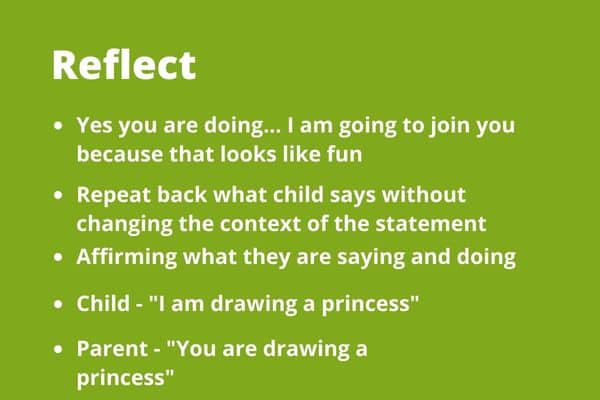
The next one is reflect. This means saying: “Yes, you are doing a good job and I’m going to join you because that looks fun”.
So you’re repeating back what the child says without necessarily changing the context of the statement and also affirming what they’re saying and doing.
So the child might say, “I’m drawing a princess”, and the parent would say, “you’re drawing a princess”.
And this can be really good also for when children are learning words and they’re saying the wrong words, or they’re mixing two words together, it’s a great way to just repeat and reflect what they meant to say.
If they said something silly, you could correct it. But you’re not correcting them, you’re saying: “You are drawing a princess. You are riding a horse”. They said: “They’re riding a camel, you’re riding a horse”.
How to Use the Imitate Skill with Your Child
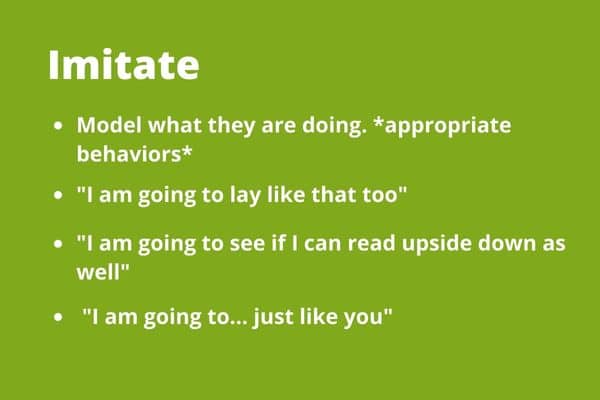
The next one is imitate. Imitating models what they are doing. This goes back to that appropriate behavior.
We don’t want to, of course, imitate poor behavior because they’re probably going to laugh and keep doing it. Saying things like: “I’m going to lay like that, too. I’m going to see if I can read upside down as well”.
I’m going to talk about teaching. In a teaching moment, you might say: “Oh, I think those books are upside down. Let’s turn it around to see if we can read it correctly. See how the letters are…”. That’s a teaching moment.
When we’re playing, we’re just acknowledging. “I see that you’re reading upside down. I want to try that, right? I’m going to do X, Y, and Z, just like you”. And again, bringing that back to adulthood when you do something and you start seeing other people do it and other people. “Oh, I like how you did that Excel form, or I like how you did this in the presentation”. You start seeing people implement those skills that you have and it feels good.
That’s the same thing that that child feels which is the same with the praise, “Oh, you do like that I’m doing this. I’m going to keep doing this. Let’s do this together”. And it’s bringing more joy into the experience because you’re doing it with that: “Coloring outside the lines. I want to color outside the lines, too”.
How to Use the Describe Skill with Your Child

Then we have describe, which is mainly narrating, what you see.
- You’re building a tower.
- You’re trying to see how high you can jump when they’re upset.
- You can acknowledge: “Your fists are getting really tight. I see that your face is getting red and scrunching. Oh, I see that you’re wanting to punch something. You’re getting mad”.
You’re describing and narrating what is happening. That shows that child that you are able to see what’s going on in their bodies. They’re not able to really connect that anger with their fists, but you’re connecting that “I am angry, I am not”. That’s the same thing as doing it in a positive way: “You’re building a tower. Look at everything that you’re doing. You’re trying to walk for it. You’re trying to somersault wow”.
They’re like: “Oh, you see me. Do you see what I’m doing? Do you like what I’m doing? Let’s keep doing it”. And all of these things are adding to it.
How to Use the Enjoy Skill with Your Child

So the next one is enjoy. It makes life better. It just does. And it shows your child you all can have fun together. It’s creating a positive relationship that helps the child focus on the puzzle. A lot of the time we know it is so much easier to remember those bad days. It’s so much easier to remember those days when the car seat doesn’t click in, the soda fell and the dog was barking and ran away.
We don’t necessarily remember that seamless day where all the kids jumped in and it was great and everything was perfect and we hit all the same lights. We might think about it maybe at the moment, but most of the time, the good just kind of goes and the bad sticks.
And that is kind of boring. We’re not focused on that positive. And so with this, you’re teaching a child to focus on the positive, to realize that also playing with the song, that playing with parents is positive.
“That’s where I feel good when I play. I feel good when I play with my parents.” That’s what you’re hoping for. I know sometimes it’s annoying when the kids just want to keep playing with you. “Mom, come do chores, come to do this, and come do that”. “I don’t want to build another Lego set”. But at the same time, that’s showing that your child wants to spend time, and your child is enjoying their time.
Next Steps
If you’re interested in learning more about parent child interaction therapy, contact us today. Unsure of where to start? Call us at 832-559-2622 to be matched with a best-fit therapist in Houston, Montrose, or Sugar Land.
For information on EMDR, click here.
Additional Resources for Parents
- Resilient Parenting Support Group
- DBT Skills Group for Parents of Teens
- For Blended Families/Families Going Through Divorce and Transition
- Play Therapy for Children
- Behavioral Therapy for Children
- Neurodiversity (ADHD/Autism) Therapy


